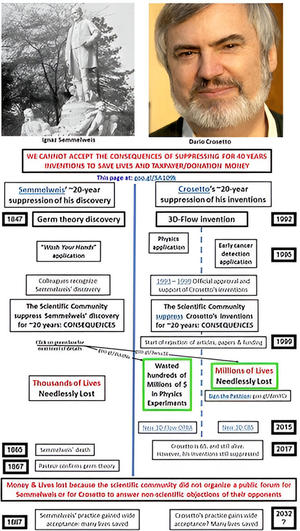New Scientific Article Reveals Evidence That CERN Wasted Over €4 Billion, Overlooked 3D-Flow Technology, and Suppressed Transparency
April 23, 2025 at 03:00 AM EDT

Italian-American scientist Dario Crosetto expresses his gratitude to the 2024 IEEE-NSS-MIC-RTSD Chairs for supporting Transparency in Science and calls for other scientific institutions to join them
DALLAS, TX, April 23, 2025 /24-7PressRelease/ -- Crosetto Foundation for the Reduction of Cancer Deaths welcomes Transparency in Science.
The 82-page scientific article (https://bit.ly/4e1uURA), unrefuted by CERN, IEEE, the Pontifical Academy of Sciences, and international experts, demonstrates that CERN has wasted over €4 billion in public funds by ignoring for more than two decades the innovative 3D-Flow architecture invented by Italian-American scientist Dario Crosetto. Instead, CERN has pursued an FPGA-based architecture that has already proven ineffective for this specific use case and is destined to fail again due to the misuse of this architecture by the scientists involved.
In 2024, the Chairs of the IEEE-NSS-MIC-RTSD conference accepted all six articles submitted by Crosetto and allocated to him the longest presentation of the entire event.
Institute of Electrical and Electronics Engineers (IEEE), is the world's largest technical professional organization with over 409,000 members (which includes also scientists, physicists, physicians, radiologists and oncologists) dedicated to advancing technology for the benefit of humanity.
No one has been able to refute Crosetto's analysis showing the inefficiency of CERN's Level-1 Triggers, including the most recent system—already partially built—for the 2026–2036 LHC experiments, which uses 20 trillion transistors and consumes 650 kW.
Crosetto's solution is based on his 3D-Flow architecture, recognized in 1993 as a breakthrough invention during a public international scientific review at FERMILAB. His system is over 100 times more efficient, consumes only 1% of, and costs 1/1000th of the current CERN design, while meeting the requirements of any LHC experiment—even at the highest luminosity levels through 2046. Yet CERN continues to ignore it.
Crosetto's inventions provide powerful cost-efficient tools for physicists to detect new particles and for doctors to detect tumors at an early, curable stage.
The loss in benefits caused by the suppression of the 3D-Flow is not limited to its applications in physics at CERN, but also extends to the field of medicine: applied to the 3D-CBS (3D-Complete Body Screening) device (invented by him in 2000 for early cancer detection), the same system could have already saved 39 million lives worldwide.
Crosetto's request is clear: a public technical debate with CERN designers to bring transparency, scientific rigor, and accountability to the use of public funds.
It is in everyone's interest—scientists, Academies of Science, CERN, IEEE, policymakers (https://bit.ly/3VEDcsg), and citizens—to address the discrepancy of using CERN FPGA-based 20 trillion transistor architecture consuming 650 kW when there is a clear alternative: the 3D-Flow architecture, proven through simulation and in hardware to solve the problem with 20 billion transistors consuming 6 kW.
The scientific truth can be achieved by disseminating this press release and the full 82-page article listed above so they reach all experts in the field who can verify and confirm the extraordinary difference in cost and performance between CERN's project and Crosetto's.
In the event anyone can refute anything in Crosetto's 82-page article, they should support it with calculations showing significant errors that would invalidate the huge difference in cost.
See the article written by the late Joshua Johnson, chief editor of the Focus Daily News and published twice on their front page. 1300 copies of this article (https://bit.ly/4cGZ6CD), along with the next 3 pages from the Focus Daily News supporting the article, were authorized by the General Chair of the 2017 IEEE-NSS-MIC-RTSD conference held in Atlanta, Georgia, to be distributed to the scientists at their conference venue.
Crosetto Foundation for the Reduction of Cancer Deaths is a tax-exempt 501(c)(3) organization with the mission to "Significantly Reduce Premature Cancer Deaths at a Lower Cost per Life Saved Compared to Current Cost."
To learn more or support the foundation, visit crosettofoundation.org
Crosetto Foundation has received the Gold Seal for transparency for 8 consecutive years from: https://www.guidestar.org/profile/03-0544575
---
Press release service and press release distribution provided by https://www.24-7pressrelease.com
More News
View More
Whirlpool’s Worst May Be Over—Upside Opportunity Ahead ↗
November 17, 2025
Via MarketBeat
Tickers
WHR


How Does D-Wave Stack Up to Quantum Rivals After Earnings Season? ↗
November 17, 2025
Via MarketBeat

Buffett Trims Apple, Bets Big on Alphabet Ahead of Retirement ↗
November 17, 2025

3 Energy Giants Amp Up Dividends—Here’s What It Means for Investors ↗
November 17, 2025
Via MarketBeat
Recent Quotes
View More
Stock Quote API & Stock News API supplied by www.cloudquote.io
Quotes delayed at least 20 minutes.
By accessing this page, you agree to the Privacy Policy and Terms Of Service.
Quotes delayed at least 20 minutes.
By accessing this page, you agree to the Privacy Policy and Terms Of Service.
© 2025 FinancialContent. All rights reserved.
>